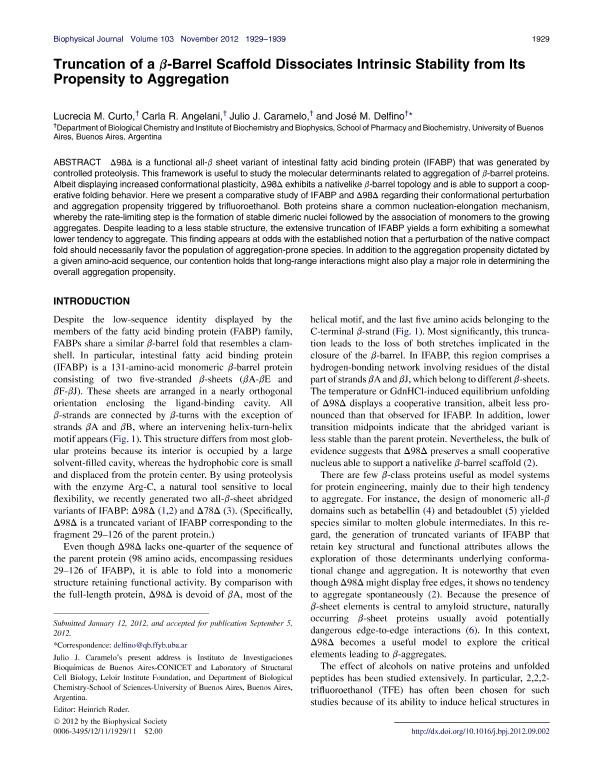Mostrar el registro sencillo del ítem
dc.contributor.author
Curto, Lucrecia María

dc.contributor.author
Angelani, Carla Romina

dc.contributor.author
Caramelo, Julio Javier

dc.contributor.author
Delfino, Jose Maria

dc.date.available
2019-01-03T17:12:09Z
dc.date.issued
2012-11
dc.identifier.citation
Curto, Lucrecia María; Angelani, Carla Romina; Caramelo, Julio Javier; Delfino, Jose Maria; Truncation of a β-barrel scaffold dissociates intrinsic stability from its propensity to aggregation; Cell Press; Biophysical Journal; 103; 9; 11-2012; 1929-1939
dc.identifier.issn
0006-3495
dc.identifier.uri
http://hdl.handle.net/11336/67297
dc.description.abstract
Δ98Δ is a functional all-β sheet variant of intestinal fatty acid binding protein (IFABP) that was generated by controlled proteolysis. This framework is useful to study the molecular determinants related to aggregation of β-barrel proteins. Albeit displaying increased conformational plasticity, Δ98Δ exhibits a nativelike β-barrel topology and is able to support a cooperative folding behavior. Here we present a comparative study of IFABP and Δ98Δ regarding their conformational perturbation and aggregation propensity triggered by trifluoroethanol. Both proteins share a common nucleation-elongation mechanism, whereby the rate-limiting step is the formation of stable dimeric nuclei followed by the association of monomers to the growing aggregates. Despite leading to a less stable structure, the extensive truncation of IFABP yields a form exhibiting a somewhat lower tendency to aggregate. This finding appears at odds with the established notion that a perturbation of the native compact fold should necessarily favor the population of aggregation-prone species. In addition to the aggregation propensity dictated by a given amino-acid sequence, our contention holds that long-range interactions might also play a major role in determining the overall aggregation propensity. © 2012 Biophysical Society.
dc.format
application/pdf
dc.language.iso
eng
dc.publisher
Cell Press

dc.rights
info:eu-repo/semantics/openAccess
dc.rights.uri
https://creativecommons.org/licenses/by-nc-sa/2.5/ar/
dc.subject
Barril Beta
dc.subject
Agregacion
dc.subject
Tfe
dc.subject.classification
Biofísica

dc.subject.classification
Ciencias Biológicas

dc.subject.classification
CIENCIAS NATURALES Y EXACTAS

dc.title
Truncation of a β-barrel scaffold dissociates intrinsic stability from its propensity to aggregation
dc.type
info:eu-repo/semantics/article
dc.type
info:ar-repo/semantics/artículo
dc.type
info:eu-repo/semantics/publishedVersion
dc.date.updated
2019-01-02T19:39:02Z
dc.journal.volume
103
dc.journal.number
9
dc.journal.pagination
1929-1939
dc.journal.pais
Estados Unidos

dc.journal.ciudad
Nueva York
dc.description.fil
Fil: Curto, Lucrecia María. Consejo Nacional de Investigaciones Científicas y Técnicas; Argentina. Universidad de Buenos Aires. Facultad de Farmacia y Bioquímica. Departamento de Química Biológica; Argentina
dc.description.fil
Fil: Angelani, Carla Romina. Consejo Nacional de Investigaciones Científicas y Técnicas; Argentina. Universidad de Buenos Aires. Facultad de Farmacia y Bioquímica. Departamento de Química Biológica; Argentina
dc.description.fil
Fil: Caramelo, Julio Javier. Consejo Nacional de Investigaciones Científicas y Técnicas; Argentina. Universidad de Buenos Aires. Facultad de Farmacia y Bioquímica. Departamento de Química Biológica; Argentina
dc.description.fil
Fil: Delfino, Jose Maria. Consejo Nacional de Investigaciones Científicas y Técnicas; Argentina. Universidad de Buenos Aires. Facultad de Farmacia y Bioquímica. Departamento de Química Biológica; Argentina
dc.journal.title
Biophysical Journal

dc.relation.alternativeid
info:eu-repo/semantics/altIdentifier/doi/https://dx.doi.org/10.1016/j.bpj.2012.09.002
dc.relation.alternativeid
info:eu-repo/semantics/altIdentifier/url/https://linkinghub.elsevier.com/retrieve/pii/S0006349512010144
Archivos asociados
